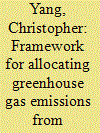| Srl | Item |
| 1 |
ID:
115699


|
|
|
|
|
| Publication |
2012.
|
| Summary/Abstract |
?he European passenger car certification test constitutes the basis for implementation and progress monitoring of the current CO2 abatement policy. The certification test is performed over a single driving cycle, (New European Driving Cycle-NEDC). The dynamics of NEDC and the fact that it does not account for other factors results in CO2 emissions which are non-representative of real-world performance. Using available data from the CO2 monitoring database and literature and employing simple vehicle dynamics model and stochastic techniques, this paper attempts to calculate the average gasoline and diesel passenger car characteristics, investigate how the evolution of certain vehicle characteristics affects real world vehicle performance and to combine the above in order to evaluate the progress in terms of real world emissions and possible correction of existing emission factors. The analysis reveals that reductions over NEDC are generally reflected over real world. There were indications particularly for diesel vehicles that the NEDC-real world CO2 emissions gap gradually widens and that existing emission factors should be amended accordingly. Currently this difference between certification and real world emission is estimated between 20 and 25%. The benefit of diesel vehicles compared to their gasoline equivalents in terms of CO2 emissions appears to reduce.
|
|
|
|
|
|
|
|
|
|
|
|
|
|
|
|
| 2 |
ID:
124624


|
|
|
|
|
| Publication |
2013.
|
| Summary/Abstract |
This paper describes a number of different allocation methods for assigning greenhouse gas emissions from electricity generation to charging plug-in electric vehicles. These methods for calculating the carbon intensity of electricity are discussed in terms of merits and drawbacks and are placed into a framework to aid in understanding the relation with other allocation methods. Three independent decisions are used to define these methods (average vs. marginal, aggregate vs. temporally-explicit, and retrospective vs. prospective). This framework is important because the use of different methods can lead to very different carbon intensities and studies or analyses that do not properly identify the methods used can confuse policymakers and stakeholders, especially when compared to other studies using different methods.
|
|
|
|
|
|
|
|
|
|
|
|
|
|
|
|
| 3 |
ID:
150919


|
|
|
|
|
| Summary/Abstract |
Studying temporal patterns in emissions associated with electricity generation is increasingly important. On the supply side, there is interest in integrating renewable energy sources (solar, wind), which are known to vary daily and hourly. On the demand side, the concept of demand response is driving a need to better understand the impact of peak versus off-peak loading, with the objective of maximizing efficiency. In this study, we examine the case of electric power generation in Singapore, and aim to assess the half-hourly variation in associated average carbon dioxide emissions. Given the country’s serious push for clean energy solutions and a possibility of adopting carbon trading in the future, we feel the need to address the currently existing gap in research on daily CO2 emissions patterns. By associating representative electricity generation data with the characterized fleet of power plants, half-hourly emissions are found to range between 415 and 455 kg CO2 per MW h. Marginal emission factors show a fluctuating daily pattern between 390 and 800 kg CO2/MW h. Policy makers able to work with real generation data can use this approach to understand the carbon footprint of short-term supply and demand interventions.
|
|
|
|
|
|
|
|
|
|
|
|
|
|
|
|